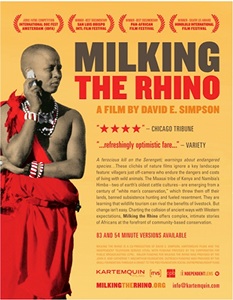Film explores community oriented conservation issues facing Africans

Milking the Rhino
One of the biggest challenges facing conservation minded individuals and organizations in Southern and Eastern Africa is native populations and their cultural dislike, even hatred, of predators. While many animals live within protected areas such as national parks and private reserves others compete for natural resources and land with local populations. As the number of animals and the genetic diversity dwindles Africans face some difficult choices for the long term: Share existing resources in spite of their attitudes toward the animals or, eventually, lose what is left of the once abundant predator populations.
Even if cattle are considered their prime source of wealth should tribal leaders as well as local and national governments strive to protect resources including predators which have historically been considered worthless or worse, enemies, for many indigenous peoples? What are the possible benefits and detriments of these policies? What is the best way to go about implementing them and much time will it take to see the results?
In Milking the Rhino, filmmaker David E. Simpson dedicated an 83-minute documentary, released in 2008, to exploring the topic. For this purpose he and his team traveled to Kenya and Namibia where they spoke with and interviewed local tribe members and leaders about conservation issues and how they are dealing with them. Of four locations his team explored initially they selected two for filming Il Ngwesi in Kenya and Marienfluss Conservancy in Namibia. Both groups are cattle centric yet wishing to learn to exploit their natural resources to expand their economies.
“Most of the conservation world is now of the consensus that for wildlife to survive and to do well in a meaningful way, there has to be some stake in its survival there has to be some stake for people rural people, who live amongst them,” said Simpson who believes many people in the northern hemisphere still rely on the outdated fortress model of building fences around a reserve as a means of conservation.
There was a lot of pre-production work for the film, especially in Namibia due to extensive paperwork (visa and film permits) requirements and a high percent of remote filming locations. Some of the locations were three day’s drive from the main city and had little to no electricity, requiring the team to be self sufficient and rely on their own camping gear.
“There are a lot questions about whether those two places (portrayed in the film) will work. So, it’s by no means sure that this is a formula that can be prescribed successfully. But what we did feel in terms of a sense of hopefulness, was that there were some really, really commited people, like our two main characters, John and James, who are passionate and commited and smart and are going to try and make things work for these communities in our film,” said Simpson.

Click here to buy Milking the Rhino







